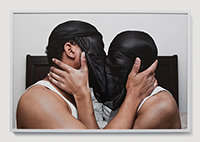Comments/Context: Whether we are comfortable admitting it or not, if we look back across the history of photography at how photographers have approached the broad concept of masculinity, the vast majority of work has addressed the specific attitudes and roles of white heterosexual men. In recent decades, the perspectives of white homosexual men and black heterosexual men have entered the photographic conversation more consistently, bringing in much needed alternate viewpoints on everything from what it means to be a man (or father or son or husband etc.) to more intimate ideas concerning the nature of desire and the topography of male bodies. But in large part, the thoughts of black homosexual men have largely been overlooked in this realm of photography – while gay black men have often been objects of desire (using Robert Mapplethorpe’s work as an example), we have rarely seen the realities of the world from behind their eyes.
D’Angelo Lovell Williams has bravely stepped into this underappreciated void with his first solo show at Higher Pictures. Primarily using his own body as the stage for explorations of the nuances of black queer identity, his pictures resonate with formal directness, balancing between meticulous control and authentic vulnerability.
Most of the works in this show investigate Williams’ own body, his intense looking at himself evidence of an active and ongoing internal struggle with how to express his particular worldview. While the stereotypical black male body we have come to expect in photography is usually sleek, muscular and naturally athletic, Williams seems altogether normal. As a result, some of his pictures push on these physical parameters and definitions of beauty, twisting his body into a flexible inverted handstand or sucking in his stomach to the point that it appears like he’s just taken off a corset, the swirling lines of the plywood behind him echoing the distorted curve of his belly.
In many ways, these photographs deliberately probe the limits of black masculinity, and others extend this study further via more evocative (and provocative) setups. Williams daintily sits on a sheepskin holding a pot of fake flowers, kneels on all fours in the grass wearing a silk robe, and seductively raises a black cloth that exposes his legs and the implication of his crotch, and these poses undeniably wander toward what we think of as femininity, or at least the well established art historical representations of such. His presence as a gay black male in these stylized scenes gives them an altogether different emotional trajectory, muddying the water in terms of roles and behaviors. The same can be said for a tender self-portrait of Williams lying on his side looking into the camera – it’s a picture brimming with quiet honesty and openness, and one that pushes back against shopworn clichés of male strength and ruggedness.
Two images in the show introduce a spiritual angle into these charged aesthetics. One scene finds Williams kneeling in a shallow pond (alluding to the rite of baptism), his head thrown back in a kind of ecstatic trance, his thoughts deep within himself. And another finds him sitting in a chair looking sideways at the camera, an unlikely pinecone attached to his forehead like a sign of the Third Eye. Both allude to a sense of consciousness and enlightenment, his path as a gay black man rich in the resonance of higher powers.
The strongest image in the show captures two black men kissing, their du-rags twisted around to cover their faces like wedding veils. It’s a relatively simple picture, but one filled with plenty of symbolic heft. Its power lies in the inversion of the youthful swagger normally associated with the du-rag and the replacement of that preening toughness with the intimate tenderness of a passionate embrace. The hands in the photograph are gentle and caressing, making the whole scene full of love, the overt contrast of the du-rags and the emotions a wonderfully poignant contradiction.
In this introductory outing, Williams has shown that he can thoughtfully unpack the complexities of being a black gay man, and we are all better off for the inclusion of his sensitive perspective in the larger dialogue around the nuances and definitions of masculinity. His photographs offer a promising combination of authentic frankness and attentive craftsmanship, his pictures opening up windows to both joys and traumas we haven’t seen before.

